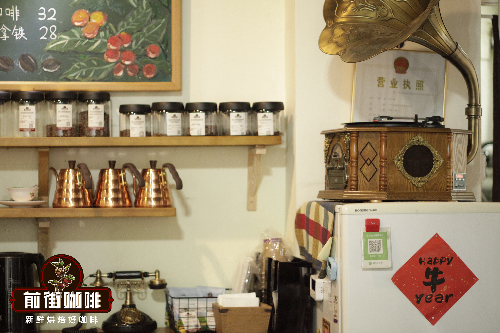Essential basic knowledge of Ethiopian Coffee-Flavor Story of Ethiopian washed Coffee Bean producing area

Professional coffee knowledge exchange more coffee bean information please follow the coffee workshop (Wechat official account cafe_style)
Basic knowledge of Ethiopian Coffee
Overview
Land area: 1104300 square kilometers
Capital: Adis (Addis Ababa)
Trading city: Dre Dawa (Dinosaur Dawa)
Population: 102774044 (May 2017)
Language: Amharic (official), Oromo, Somalia
▲ Coffee growing area Map of Ethiopia
Overview of producers
Coffee practitioners: about 700000 people
Average plantation area: 1 hectare
Annual output: 3.5 million bags
An overview of coffee
Producing areas: Sidama, Yirgacheffe, Harrar, Limu, Djimma, Lekempti
Coffee variety: Isobian native species
Treatment: washing, solarization
Grading standard (local): the grades of washed raw beans are G1 (defect 0-3) and G2 (defect 4-12)
Sun-dried raw bean G3 (defect 13-25) G4 (defect 25-45) G5 (defect 46-100)
Weight of each bag of coffee: 60 kg
Harvest time: November to December
Delivery time: May to June of the next year
▲ coffee harvest schedule
History
Ethiopia has an almost legendary status among coffee-producing countries, not only because it is the "birthplace" of Arabica coffee, but also because it is different from most coffee-growing countries, coffee is not a plant that colonizes foreign cash crops. Growing, processing and drinking coffee has been part of the local way of life for centuries, and it was first discovered that coffee grown in the forest was gradually artificially grown for household use and commercial sale.
From an outsider's point of view, Ethiopian coffee has a huge and complex cultural, political and economic impact. Ethiopian coffee has amazing genetic diversity, and almost 99% of coffee varieties can be found in Ethiopia. (roast magazine recently reported that due to climate change, as well as variety research and other reasons, the genetics of the original Ethiopian coffee varieties are being destroyed, which should be paid attention to.
Another unique feature of Ethiopian coffee is the very high domestic consumption, as coffee plays a very important role in the daily life of the Ethiopian people. Of the 6.5 million bags produced in the country, about 3 million bags are consumed domestically and another 3.5 million bags are exported.
Coffee is still part of a traditional "ritual" preparation, a way of reuniting family, friends and partners. The oldest woman in the family would fry the coffee in a pan, grind it up, and cook it in a pot called "jebena". She filled the thick coffee in a small cup. Then add fresh boiling water and make the coffee in the pot twice. This process takes about an hour from the beginning to the end, which is a sign of hospitality.
Most coffee growers in Ethiopia belong to small farmers, most of which cover less than 1 hectare. There are large private coffee farms, as well as cooperatives of small and medium-sized farms, where growers produce only a relatively small amount of commercial coffee raw beans.
Summary of coffee processing and flavor
Coffee is produced in several ways in Ethiopia. In large private estates, coffee picking, processing and shelling are usually done on the estate. Other small farmers will send the fresh fruits of their coffee to the nearest processing station. There their fresh coffee fruit is sold at a certain price and mixed with the fresh coffee fruit of other farmers and processed according to the requirements of the processing station.
In addition, there is a better cooperative Co-op organization similar to the peasant association, in which the members of the cooperative will send their fresh coffee to the processing station designated by the cooperative. In this way, the coffee will have better traceability, because the coffee comes from the regular members of the cooperative. With the increasing emphasis on coffee quality and industry transparency, coffee traceability is very important.
The flavor of Ethiopian coffee has a variety of flavors due to a variety of factors, including varieties, treatments and the unique microclimate of micro-batch plots. The general experience is that sun-processed coffee has a more obvious taste of fruit and dark chocolate, usually with a bit of wine-like characteristics and a better thickness. Coffee processed with water will also have more acidity.
Harrar: coffee is almost all sun-treated and has a unique chocolate and nutty flavor that reflects the dry climate in which coffee grows.
Sidama: a vast coffee-producing area located in the south, including Guji and the famous Yirgacheffe.
The following are some of the familiar small producing areas in Yejia Xuefei (Yejiaxue) producing areas:
Adado (ADADO): exquisite drupe fruits, citrus, floral aroma, structural balance.
Aretha (ARICHA): complex, nearly tropical, juicy fruit, sweet sugar and flowers.
KOCHERE: it's like fruit tea. Citrus, drupe fruit
KONGA: peaches and apricots, more stone fruit aromas, and a strong lime.
About the spelling of Ethiopian place names: there are many confusion and inconsistencies in the spelling of Ethiopian coffee, in part because Amharic does not use Roman letters like English, so it is not necessarily wrong to spell the area as Jejah, Yirgachefe, or even Yirga Chefe. With regard to Sidamo and Sidama, we note that "Sidamo" is a somewhat derogatory variant in place names because the more acceptable Sidama should be used.
[Ethiopian Commodity Exchange]
Important Notice :
前街咖啡 FrontStreet Coffee has moved to new addredd:
FrontStreet Coffee Address: 315,Donghua East Road,GuangZhou
Tel:020 38364473
- Prev

Description of flavor characteristics of Ethiopian coffee beans Price recommendation of Ethiopian boutique coffee beans
Professional coffee knowledge exchange more coffee bean information please follow the coffee workshop (Wechat official account cafe_style) Ethiopia is the hometown of Arabica coffee, it is in the forests of the Kaffa region that you can see wild Arabica coffee. In Ethiopian, coffee
- Next

Rwanda wants to export 24500 tons of coffee in 2018. How much is the coffee from Rwanda?
For more information on coffee beans, please follow the coffee workshop (Wechat official account cafe_style) Rwanda's National Agricultural Export Development Agency (NAEB) said recently that the country is working to improve the total quantity and quality of coffee exports, with a target of 24500 tons in 2018. Cyrus Ding Getaraya, manager of NAEB Coffee Department, said Rwanda Coffee in 2016
Related
- Detailed explanation of Jadeite planting Land in Panamanian Jadeite Manor introduction to the grading system of Jadeite competitive bidding, Red bid, Green bid and Rose Summer
- Story of Coffee planting in Brenka region of Costa Rica Stonehenge Manor anaerobic heavy honey treatment of flavor mouth
- What's on the barrel of Blue Mountain Coffee beans?
- Can American coffee also pull flowers? How to use hot American style to pull out a good-looking pattern?
- Can you make a cold extract with coffee beans? What is the right proportion for cold-extracted coffee formula?
- Indonesian PWN Gold Mandrine Coffee Origin Features Flavor How to Chong? Mandolin coffee is American.
- A brief introduction to the flavor characteristics of Brazilian yellow bourbon coffee beans
- What is the effect of different water quality on the flavor of cold-extracted coffee? What kind of water is best for brewing coffee?
- Why do you think of Rose Summer whenever you mention Panamanian coffee?
- Introduction to the characteristics of authentic blue mountain coffee bean producing areas? What is the CIB Coffee Authority in Jamaica?

